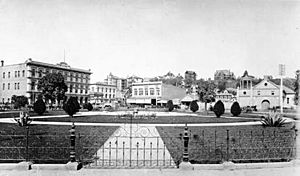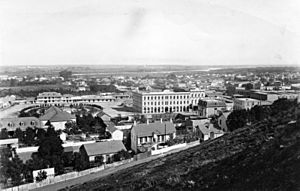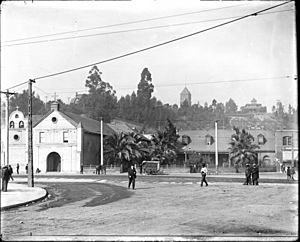Los Angeles Plaza facts for kids
The Los Angeles Plaza (also known as Plaza de Los Ángeles) is a historic public space in Los Angeles, California. It's the main point of the Los Angeles Plaza Historic District. When Governor Felipe de Neve first created the Pueblo de Los Ángeles, he chose this spot as the center of the new town. The original plaza was a rectangle, measuring about 75 by 100 varas (an old Spanish measurement). It was located north of the church, and important buildings like the guard house and chapel faced it.
The plaza is just north of an old village site called Yaanga. This village was used as a reference point when the plaza was built.
Contents
The Old Plaza (1700s)
The first plaza, sometimes called plaza vieja (old plaza), was created in the 1700s. Governor Felipe de Neve planned it carefully in 1781. It was a parallelogram, about 100 varas long and 75 varas wide. The corners faced the main compass directions (north, south, east, west). Streets were designed to run straight off its sides, so they wouldn't be too windy.
Houses were built around three sides of the plaza. The fourth side was saved for public buildings like a guard house and a town hall. The early settlers lived in simple mud huts around this old plaza. Later, an adobe wall was built around the town. This wall helped keep cattle and goats from wandering into the town from the common grazing lands outside.
The New Plaza (1800s)
Building the New Church and Plaza

In 1814, construction began on the La Iglesia de Nuestra Señora la Reina de los Ángeles church. It was meant to face the old plaza. However, a big flood in 1815 changed the Los Angeles River's path. The floodwaters reached the church's foundation. Because of this, the church's location was moved to higher ground, where it stands today.
After the new church site was chosen in 1818, people realized a new plaza was needed in front of it. So, a new plaza, the plaza nueva, began to take shape from common land and house lots. Some buildings were already in the area. Records show that in 1825, town leaders ordered a house on the plaza torn down.
Growth and Changes
Before 1818, the town mostly grew northward. But once the new church was planned, growth shifted southward. In 1821, José Antonio Carrillo, an important person in the town, asked for a house lot near the new church. He was given a lot where the Pico House stands today. Between 1821 and 1823, Carrillo built a large home facing the new plaza.
Having a house facing the plaza became popular among the town's important families. Soon, the homes of families like the Picos, Carrillos, and Sepulvedas were built around the square.
Shaping the Plaza
There wasn't a clear plan for the new plaza at first. The building line wasn't straight. If someone built their house too far out, the town leaders would have it torn down. For example, in 1838, Santiago Rubio's house was demolished to keep the plaza line straight.
As more lots around the plaza were built on, its uneven shape became more obvious. The town council (Ayuntamiento) tried to make the plaza more square. They faced challenges, as some landowners didn't want to move their properties. Eventually, they managed to make the plaza more regular. After these changes, the north, south, and west sides were about 380 feet long, and the east side was about 330 feet long.
Improvements and a Fountain
For many years, the plaza was just a dusty, treeless area. Horses were often tied there, making it even dustier. It was only cleaned and decorated once a year for a festival. Even after California became part of the United States, its look didn't change much for a decade.
The first real attempt to improve the plaza was in 1859. A picket fence was built, paths were laid, and some plants were added. However, the city often didn't have enough money, so these improvements weren't kept up. The plaza slowly returned to its old, run-down state.
In 1868, the city made a deal with a water company. One condition was that the company had to build a fancy fountain on the plaza within a year, costing up to $1,000. It took a few years, but eventually, the company built the fence, laid the paths, and put up the ornamental fountain. The plaza's shape was also changed from a square to a circle.
Los Angeles Plaza Park
Today, part of the plaza is known as Los Angeles Plaza Park. It's also called Father Serra Park. This area is open to the public and was once the site of the demolished Lugo Adobe building.





